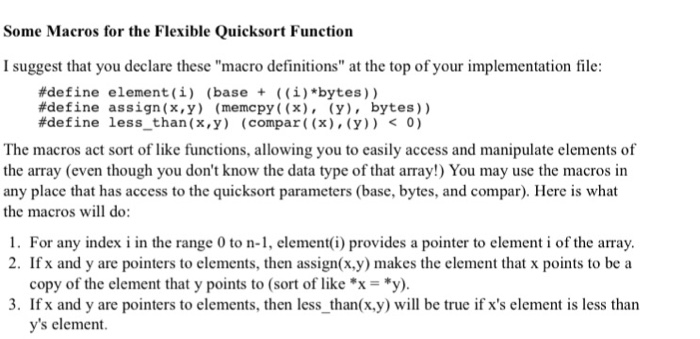Answered step by step
Verified Expert Solution
Question
1 Approved Answer
C++, please help me. This is code I had so far(above the picture). How to code the Partition Funtion from description above, can someone code
C++, please help me. 


This is code I had so far(above the picture). How to code the Partition Funtion from description above, can someone code it for me?
Some Macros for the Flexible Quicksort Function I suggest that you declare these "macro definitions" at the top ofyour implementation file: #define elements (i) (base ((i) bytes) #define assign (x,y) (memcpy (x), (y), bytes)) define less than (x, y) (compar ((x), (y)) 0) The macros act sort of like functions, allowing you to easily access and manipulate elements of the array (even though you don't know the data type of that array!) You may use the macros in any place that has access to the quicksort parameters (base, bytes, and compar). Here is what the macros will do: l. For any index i in the range 0 to n-1, element(i) provides a pointer to element i of the array. 2. If x and y are pointers to elements, then assign(x,y) makes the element that x points to be a copy of the element that y points to (sort of like "xa y). 3. Ifx and y are pointers to elements, then less than(x,y) will be true if x's element is less than y's element. Some Macros for the Flexible Quicksort Function I suggest that you declare these "macro definitions" at the top ofyour implementation file: #define elements (i) (base ((i) bytes) #define assign (x,y) (memcpy (x), (y), bytes)) define less than (x, y) (compar ((x), (y)) 0) The macros act sort of like functions, allowing you to easily access and manipulate elements of the array (even though you don't know the data type of that array!) You may use the macros in any place that has access to the quicksort parameters (base, bytes, and compar). Here is what the macros will do: l. For any index i in the range 0 to n-1, element(i) provides a pointer to element i of the array. 2. If x and y are pointers to elements, then assign(x,y) makes the element that x points to be a copy of the element that y points to (sort of like "xa y). 3. Ifx and y are pointers to elements, then less than(x,y) will be true if x's element is less than y's elementStep by Step Solution
There are 3 Steps involved in it
Step: 1

Get Instant Access to Expert-Tailored Solutions
See step-by-step solutions with expert insights and AI powered tools for academic success
Step: 2

Step: 3

Ace Your Homework with AI
Get the answers you need in no time with our AI-driven, step-by-step assistance
Get Started


